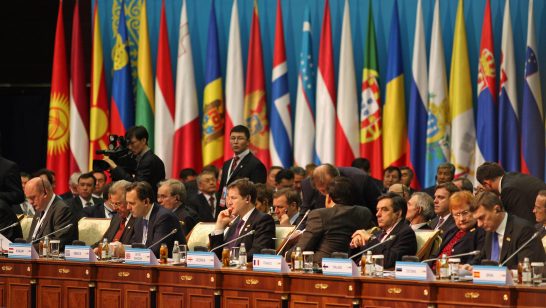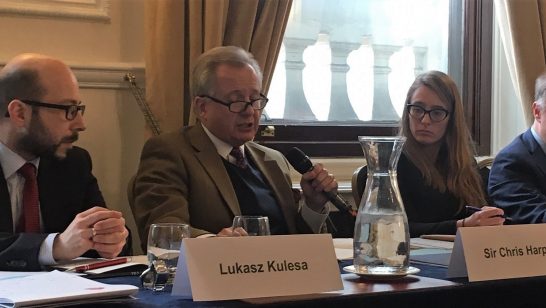
Among Western politicians and political commentators, the verdict is unanimous: it was very fortunate that Switzerland chaired the OSCE in 2014. During the Ukraine crisis, Swiss President Didier Burkhalter stood up to the challenge. With his active diplomatic efforts, he achieved notable success. After Russia’s annexation of Crimea, Switzerland brought the foreign ministers of Russia and Ukraine to the negotiating table for the first time, which lead to the Geneva Agreement of April 2014. On behalf of the OSCE, Swiss diplomat Heidi Tagliavini facilitated a fragile ceasefire agreement between Moscow, Kyiv, and pro-Russian separatists in East Ukraine. Although no political declaration could be adopted at the Basel OSCE Ministerial Council in December 2014, Burkhalter innovatively listed the problems with Moscow in his “summary of the first day of discussions“, publicly stating the disagreements between the West and Russia. During the meeting in Basel, he also launched an independent panel of experts that was tasked with delivering a report by the end of 2015 on the lessons learned from the Ukraine Crisis for the European security order.
Yet, the greatest success of the Swiss OSCE presidency was the achievement of a unanimous decision on 21 March 2014 to send a Special Monitoring Mission (SMM) to Ukraine. Thus, the OSCE was responding very quickly and effectively to the Russian land grab in Crimea. Just a week after the political decision in Vienna, the SMM was present with civilian monitors in the ten regions mentioned in the OSCE decision of 21 March. These monitors were withdrawn on short notice from other OSCE field missions and temporarily sent as first responders to Ukraine. Since then, the OSCE is the only international organization that impartially and objectively reports about the situation in the disputed territories, first with 100, then with 250, and currently with over 450 international observers. To this day, the SMM represents a credible independent source of information about the civil war in East Ukraine. In a conflict in which propaganda and disinformation are massively employed by all sides, the OSCE plays a crucial role in lifting the fog of war. With its reports on the plight of internally displaced persons as well as with its monitoring of prisoner exchanges, the SMM also actively contributes dialogue and de-escalation measures. Furthermore, the SMM coordinates local ceasefires and establishes humanitarian corridors to evacuate people from encircled areas.
The rapid deployment of OSCE observers was only possible because the OSCE Secretariat was better prepared to act more quickly in the event of a crisis since the bitter experiences in Georgia (2008) and Kyrgyzstan (2010). Thanks to an internal database of volunteers and a virtual pool of equipment including armored vehicles, laptops, satellite phones, and flak jackets, the OSCE succeeded in 2014 in quickly sending observers and material to Ukraine.
That Switzerland was able to create unanimity among the 57 OSCE member states to mandate the SMM was by no means self-evident. The SMM is the largest ever deployed OSCE field mission and the first newly mandated OSCE field mission in over ten years. Its budget for the first 12 months amounted to EUR 57 million, the total annual budget of the OSCE representing only EUR 142 million. The funds were provided by additional contributions from member states. The mission’s mandate was extended both on 22 July 2014 and on 12 March 2015 –consensus decisions were needed on both instances. The fact that both the Western OSCE states and Russia gave the green light for the SMM on three occasions is an indication that both sides consider the OSCE as a relevant and useful security organization, even when the Ukraine crisis had further intensified and when Russia militarily intervened in East Ukraine.
Over the last year, the SMM had to adapt repeatedly to a constantly changing conflict environment with an ever-changing front line. After its tasks had originally been outlined in March 2014, the SMM already had to take on a new task just one month later – by playing the lead role in implementing the Geneva Agreement. The presence of the SMM on site proved useful after the tragic downing of MH17 in July 2014. By using a video link with the rebels of Donetsk and Lugansk, Heidi Tagliavini’s Trilateral Contact Group succeeded in securing immediate access for OSCE monitors and Dutch experts to the crash site. After the Minsk Protocol of September 2014, the SMM was also assigned to monitor the shaky armistice – actually a task for a military peacekeeping operation that overwhelmed the civilian staff of the SMM – and to monitor the Ukrainian-Russian border, an almost impossible task. To screen this porous border, the SMM also partly relies on the use of drones. According to the new character of the peacekeeping mission, the OSCE began to recruit observers with a military background. Since February 2015, the SMM is also monitoring the withdrawal of heavy weapons from the 500 kilometer contact line behind agreed lines of retreat, as agreed in the Minsk II Agreement.
The mission faced formidable challenges. Because of several kidnappings (initially of Western military observers sent under the Vienna Document, but later also of OSCE employees themselves), the SMM was distracted from its main tasks and had to focus its resources instead on liaising with the kidnappers and negotiating for the release of the hostages. The security of the OSCE monitors dramatically worsened also when Kyiv launched a military offensive into East Ukraine in April 2014. The SMM decided to continue its activities henceforth only in the government-controlled parts of Ukraine. Thus, during the summer of 2014, the “eyes and ears” of the international community were largely blind and deaf in the regions of Lugansk and Donetsk which were controlled by pro-Russian separatists. During that time, the SMM was unable to independently verify accusations of direct Russian military support to the separatists.
Nevertheless, with its re-established presence in East Ukraine since the fall of 2014, the SMM now again deters a full-fledged Russian military invasion by serving as a “trip wire”. In February 2015, despite a delicate security situation and problems at checkpoints, 226 (of 412) international OSCE observers were present in the regions of Donetsk and Lugansk, even if their access to the actual area of conflict remained limited. The SMM serves as the foundation for an eventual permanent international peace support operation in the future.
Although no miracles should be expected from the SMM, a comparison with the Russo-Georgian War in 2008 illustrates how well the OSCE has responded to Russia’s annexation of Crimea. In August 2008, the EU under the French presidency (and a bustling Nicolas Sarkozy) dominated Western crisis management, while an existing OSCE mission to Georgia had to close at the end of 2008 due to Russian pressure.
The OSCE under the Swiss presidency staged an amazing comeback during the Ukraine crisis, after having continuously lost relevance in the previous 15 years. It is to be hoped that the OSCE under the current Serbian and future German and Austrian leadership will pursue the active and successful Swiss crisis management efforts in the coming years.
The opinions articulated above represent the views of the author(s), and do not necessarily reflect the position of the European Leadership Network or any of its members. The ELN’s aim is to encourage debates that will help develop Europe’s capacity to address the pressing foreign, defence, and security challenges of our time.



